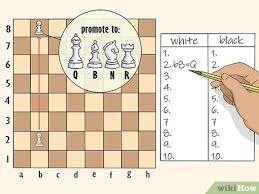
How to Learn Algebraic Notation in Chess: A Step-by-Step Guide
Algebraic notation is the standard system used to record chess moves, and learning it is essential for studying games, analyzing openings, and communicating effectively with other players. Whether you’re new to this system or simply looking to refresh your knowledge, here’s a step-by-step guide to mastering algebraic notation.

1. Understand the Chessboard
First, it’s crucial to understand how the chessboard is organized in terms of coordinates. The board consists of 8 ranks (numbered 1 to 8) and 8 files (labeled a to h).
- The files are represented by letters: a, b, c, d, e, f, g, h (from left to right from White’s perspective).
- The ranks are represented by numbers: 1, 2, 3, 4, 5, 6, 7, 8 (from bottom to top from White’s perspective).
This system allows you to identify any square on the board with a combination of a letter and a number. For example, the square in the bottom left corner is a1, and the square in the top right corner is h8.
2. Identify the Pieces
In algebraic notation, each chess piece has a letter representing it:
- K: King
- Q: Queen
- R: Rook
- B: Bishop
- N: Knight
- P: Pawn
Pawns are the only pieces that aren’t represented by a letter in notation. When you move a pawn, only the destination square is indicated (e.g., e4). Other pieces are always abbreviated with their corresponding letter.
3. Piece Movement
In algebraic notation, a piece’s movement is described by:
- The letter representing the piece (if it’s not a pawn).
- The destination square where the piece moves.
For example, if a knight moves to f3, the move would be written as Nf3.
4. Captures
If a piece captures another, it’s indicated with an «x» between the piece that makes the capture and the destination square. For example:
- If a bishop captures a piece on d5, the move would be written as Bxd5.
For pawns, the capture notation is written by indicating the file from which the pawn captures, followed by «x» and the destination square. For example, if a pawn from file e captures a piece on d5, the move would be exd5.
5. Special Moves
- Castling: Castling is represented as 0-0 for kingside castling (with the rook on the king’s side) or 0-0-0 for queenside castling (with the rook on the queen’s side).
- Pawn Promotion: When a pawn reaches the eighth rank and is promoted to another piece (usually a queen), it is indicated with the piece to which it is promoted. For example, a pawn promoted to a queen would be written as e8Q.
- Check: A check is indicated with a «+» after the move. For example, Qf7+ means the queen moves to f7 and gives a check to the king.
6. Practical Examples
Let’s see some examples to clarify how algebraic notation works:
- 1. e4: The pawn on the e-file moves two squares forward.
- 1… e5: The pawn on the e-file moves two squares forward (Black’s response).
- 2. Nf3: The knight moves to f3.
- 2… Nc6: The knight moves to c6.
- 3. Bb5: The bishop moves to b5.
7. Tips for Learning Algebraic Notation
- Study Famous Games: Watch and write down famous chess games using algebraic notation. There are many online resources like Chessbase or the Chessby app that allow you to view games in algebraic notation.
- Play and Record Your Moves: Practice is key. Try playing games while recording your moves in algebraic notation to become familiar with the system.
- Use Educational Resources: Books, videos, and chess apps often teach how to read and write algebraic notation. Some helpful resources are:
8. Conclusion
Learning algebraic notation is a fundamental skill for improving at chess. It will not only help you study and analyze games but also enable you to communicate effectively with other players. With some practice, you’ll master this system and be able to focus more on the game’s strategies.
If you’d like to dive deeper into other areas of chess, feel free to keep exploring!

Chessby: Connecting Chess Enthusiasts Worldwide
Chessby is a unique platform designed to bridge the gap between the digital and physical worlds of chess. Its main purpose is to connect chess enthusiasts by helping them find local places, events, and players for in-person games.
